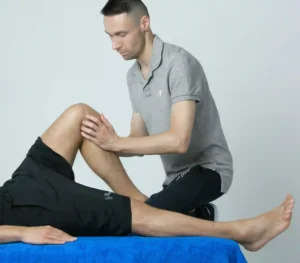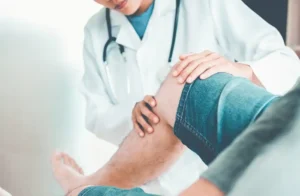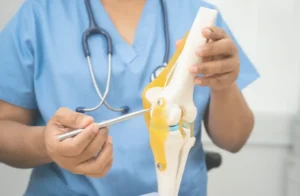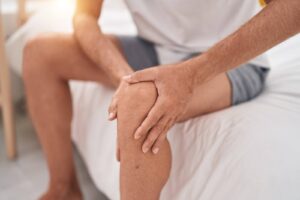
Understanding Osteoarthritis: How It Affects the Knee Joint
Knee pain can change how you move, work, and live your daily life. For millions of people, that pain is caused by osteoarthritis, a condition that slowly wears away the joint cartilage meant to cushion and protect the bones.
At first, it might feel like occasional stiffness or a little discomfort after a long day. But as osteoarthritis progresses, the affected joint can become more painful, swollen, and even harder to move.
Since the knee joint is one of the body’s main weight-bearing joints, it’s also one of the most commonly affected areas, making even simple movements like standing up or walking upstairs more painful over time.
So what exactly happens when osteoarthritis affects the knee? And more importantly, what can you do to slow it down and relieve the pain?
Key Takeaways:
- Knee osteoarthritis develops gradually, with causes ranging from aging to past injuries.
- Common symptoms include knee pain, stiffness, swelling, and reduced mobility.
- Physical therapy, exercise, and weight management can help reduce the strain on the knee joint.
- Minimally invasive treatments like genicular artery embolization (GAE) offer pain relief without surgery.
- Knee replacement surgery may be needed in severe cases when other treatments no longer work.
What Is Osteoarthritis and Why Does It Affect the Knee?
Millions of people worldwide deal with osteoarthritis (OA), making it the most common type of arthritis. It’s a degenerative joint disease that develops when the cartilage in a joint gradually breaks down, leading to joint pain, stiffness, and inflammation.
While osteoarthritis can affect any joint, it is most common in the knees, hips, hands, and spine. The knee joint, in particular, is one of the most commonly affected joints because it bears a lot of weight and absorbs repeated impact with daily movement. As the cartilage wears away, the bones rub against each other, causing pain, swelling, and reduced range of motion.
The Role of Cartilage and How It Breaks Down Over Time
To understand osteoarthritis, it helps to first understand how a healthy knee joint functions. The knee is a weight-bearing joint, meaning it supports your body whenever you walk, run, or even stand still. It connects three major bones:
- The femur (thigh bone)
- The tibia (shin bone)
- The patella (kneecap)
At the ends of these bones is a protective layer of cartilage, a slippery tissue that helps the knee move smoothly. Cartilage absorbs shock, reduces friction, and allows bones to glide past each other without pain. Think of it like a cushion that prevents bone-on-bone contact when you bend or straighten your knee.
However, cartilage is not indestructible. Over time, wear and tear, past joint injuries, excess weight, and genetics can all contribute to its gradual breakdown. When this happens:
- The cartilage thins out, providing less protection and less cushioning.
- The bones rub against each other, leading to joint damage and inflammation.
- Bone spurs (bony growths) may form, making movement even more difficult.
- The soft tissues and joint lining become irritated, increasing pain and stiffness.
Since cartilage has no blood supply, it can’t heal itself like other tissues in the body. Once it’s gone, the damage is irreversible, which is why osteoarthritis is a degenerative condition that progresses and worsens over time.
What Are the Knee Symptoms of Osteoarthritis?
Knee osteoarthritis doesn’t appear overnight. At first, you might feel minor knee pain after the activity, but as the condition progresses, symptoms become more persistent. Everyday movements, like standing up or walking, may start to feel more difficult. Common symptoms include:
- Joint stiffness, especially in the morning
- Swelling and inflammation in the knee joint
- Persistent knee pain that worsens with movement
- Grinding or popping sensations due to cartilage breakdown
- Weakness or instability, making the knee feel like it could give out
Over time, chronic knee pain and joint inflammation can limit mobility, making early diagnosis and treatment essential.
Causes and Risk Factors of Knee Osteoarthritis
Not everyone develops knee osteoarthritis in the same way. While aging plays a big role, other factors can speed up the process, making joint pain and inflammation harder to ignore.
- Age and genetics
As you get older, your joints take on more wear and tear, and cartilage doesn’t repair itself as well as it used to. If knee osteoarthritis runs in your family, you might start noticing symptoms earlier, especially if you inherited weaker joint structures or a tendency for cartilage breakdown.
- Previous injuries and surgeries
Do you have an old sports injury or accident you brushed off years ago? It might come back to haunt you. Even after healing, a damaged joint never fully functions the same, making it more vulnerable to wear and tear over time. The same goes for past knee surgeries—while they may fix immediate issues, they can sometimes increase the risk of osteoarthritis later on.
- Repetitive stress on the knee
If your job or hobbies put constant pressure on your knees, you might be wearing down joint cartilage without realizing it. Jobs that require kneeling, heavy lifting, or standing for long hours, as well as high-impact sports, can speed up the breakdown of cartilage, leading to chronic knee pain earlier in life.
- Excess weight and knee health
Your knees take the brunt of your body weight, and every extra pound adds more stress to the joint. Over time, this added pressure wears down cartilage faster, making joint pain and inflammation worse. Even a small drop in weight can reduce strain on the knees and help ease painful movement.
- Health conditions linked to osteoarthritis
Some health issues don’t just affect your overall well-being—they can also speed up joint damage. Conditions like diabetes, high cholesterol, and autoimmune diseases can contribute to inflammation and cartilage breakdown, making it harder for your joints to stay healthy.
Find out if you are a candidate
How Is Knee Osteoarthritis Diagnosed?
A healthcare provider will assess your knee joint, ask about your symptoms, and determine what is causing your persistent knee pain. Since other conditions, like rheumatoid arthritis, can have similar symptoms, further testing may be needed to confirm if you have knee osteoarthritis.
- Physical exam and medical history. A doctor will check for joint inflammation, stiffness, and limited movement while asking about pain relief methods you’ve tried. They may also ask if your knee pain gets worse with certain activities.
- Imaging tests. X-rays and MRI scans help reveal cartilage loss, bone spurs, or joint damage. Diagnostic imaging can also show if the knee lining is affected.
- Blood tests. While there is no specific blood test for osteoarthritis, doctors may use them to rule out other conditions like autoimmune diseases that also cause joint pain.
What Are the Best Treatments for Knee Osteoarthritis?
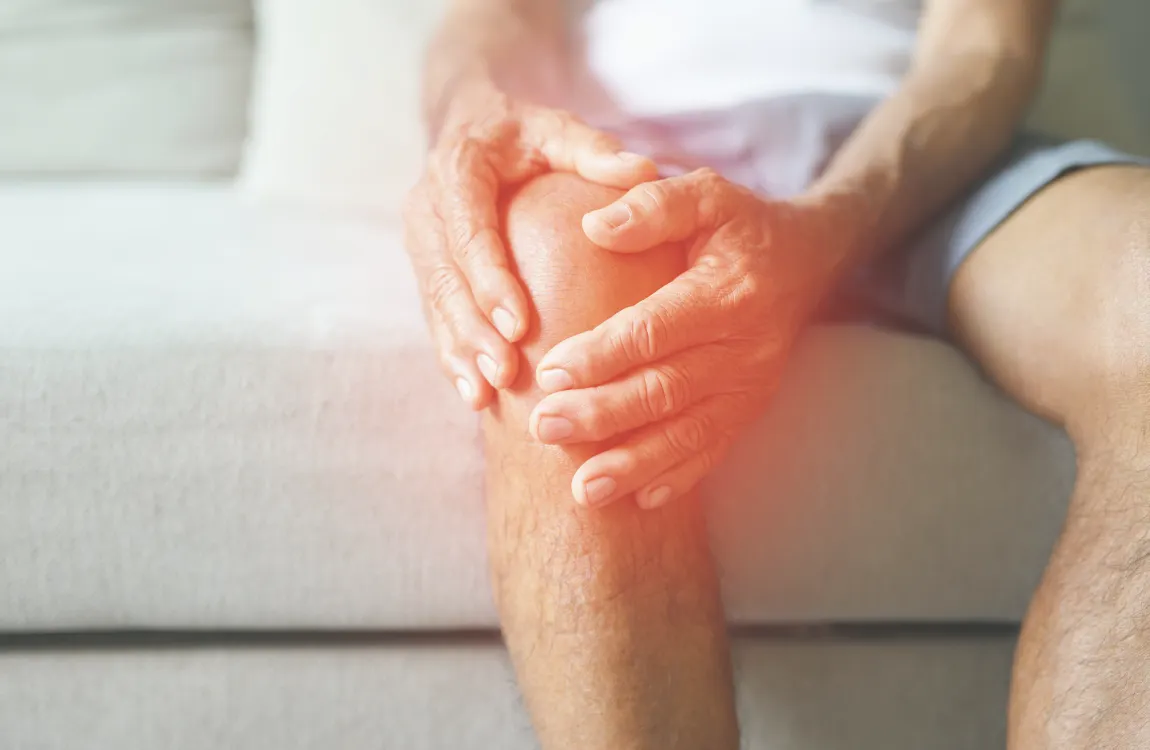
Knee osteoarthritis can make daily movement challenging, but the right treatments can help manage knee pain and keep you active. The best approach depends on pain severity, joint damage, and overall health.
Lifestyle Changes That Can Help
Staying active is one of the best ways to reduce inflammation and improve knee function. Physical therapy strengthens muscles around the knee joint, helping with stability and movement. Maintaining a healthy weight also eases the strain on the knee lining and joint cartilage, minimizing further wear and tear. Even small changes in daily habits can make a big difference.
Medications and Pain Relief Options
For mild to moderate knee osteoarthritis, pain medications like acetaminophen or anti-inflammatory medications can help with discomfort. Steroid injections may be recommended for persistent knee pain when other treatments aren’t enough. Some patients find relief with knee injections that reduce inflammation. The goal is to manage pain and swelling while keeping the knee joint as functional as possible.
Genicular Artery Embolization (GAE): A Minimally Invasive Option
For those dealing with chronic knee pain, the genicular artery embolization procedure (GAE) is a promising non-surgical treatment. This minimally invasive procedure works by using a small catheter to block the blood flow to the inflamed knee arteries, reducing pain and swelling. It’s a great option for patients who aren’t ready for knee replacement surgery and want a procedure with minimal downtime.
When Is Surgery Necessary?
If other treatments fail, knee replacement surgery may be the next step. This surgical procedure replaces the damaged knee joint with an artificial one, restoring mobility and reducing debilitating knee pain. While recovery takes time, most patients see a significant improvement in pain and function. Physical therapy after surgery helps patients return to normal activity as they heal.
How Can You Manage Osteoarthritis in Daily Life?
When you develop osteoarthritis, even simple movements can feel more difficult. That doesn’t mean you have to give up on staying active. Small adjustments to your exercise routine, diet, and daily habits can help reduce pain, protect your joints, and improve mobility. The key is to find the right balance between staying active and minimizing strain on your knee joint.
Staying Active Without Increasing Pain
Keeping your painful joints moving is essential for joint health, but the right type of activity matters. Low-impact exercises help strengthen the knee joint and hip joint without adding stress.
- Swimming, cycling, and walking keep joints flexible without high-impact strain.
- Stretching and strength training improve stability and reduce pressure on the knees.
- Physical therapy can help create a safe movement plan tailored to your condition.
Diet and Joint Health
What you eat can play a big role in managing pain and inflammation. A well-balanced diet supports cartilage health and helps prevent further joint damage.
- Omega-3 fatty acids (found in fish, nuts, and seeds) help reduce inflammation.
- Vitamin D and calcium-rich foods support strong bones and protect the knee joint.
- Antioxidant-rich fruits and vegetables help improve pain levels and fight inflammation.
Making Simple Adjustments for Less Knee Strain
Small changes can make a big difference in daily comfort. The right support and modifications can help protect your knee joint and keep you moving with less discomfort.
- Wear supportive footwear to reduce pressure on the knees.
- Use assistive devices like braces or canes for extra stability.
- Modify your home with grab bars, cushioned mats, and raised seating.
- Adjust how you move—avoiding sudden twists and heavy lifting can protect your knee joint.
Managing knee osteoarthritis is making the right choices to stay active while protecting your joints for the long run.
Taking Control of Your Knee Osteoarthritis
When knee osteoarthritis starts, it might just feel like a bit of stiffness in the morning or knee pain after a long walk. But as the symptoms worsen, everyday activities can become more difficult. The good news is that early management can make a big difference.
A physical examination is a great first step. It helps a specialist see how your knee joint is moving and whether there are signs of joint inflammation or cartilage breakdown. The sooner you address the issue, the better your chances of keeping a healthy joint and avoiding more invasive treatments down the road.
It’s important to explore all treatment options, from physical therapy and anti-inflammatory medications to minimally invasive procedures like genicular artery embolization (GAE). The right approach can help reduce pain, improve mobility, and keep you doing the things you love.
At KneePain360, we’re all about helping people manage knee pain with care and expertise. Our team offers a patient-centered approach with innovative treatments designed to provide pain relief and improve quality of life.
If you’re not sure where to start, we offer a FREE risk assessment to help you understand your condition and find the best path forward. It’s a simple step that could make a big difference.

